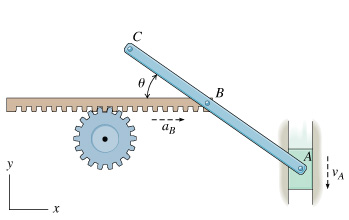Relative-Motion Analysis: Acceleration
Learning Goal:
To
be able to use the equation for relative acceleration between two
points to find unknown linear accelerations and angular accelerations of
connected bodies.

Part A - Acceleration of A
Find the acceleration of A at the instant shown. Indicate the direction with the sign based on the axes in the figure.
|
|
11.2
|
|
Part B - Acceleration of C
Find acceleration of C, aC , at the instant shown. Give your answer in component form.
|
|
3.10,-11.2
|
|
Part C - Acceleration of B
Find the acceleration of B when the acceleration of C is
aC=4.15 i+3.00 j m/s2
aA=−3.00 j m/s2
. Member ABC makes an angle of θ=19.0∘ at the instant considered.
|
|
2.08
|
|
Can somebody help me with calculating Part B and C ?
ReplyDelete